八年级英语下册Module4 Seeing the doctor Unit2Wehaveplayedfootballforayearnow
外研版八年级下册《Module4SeeingthedoctorUnit2》说课稿
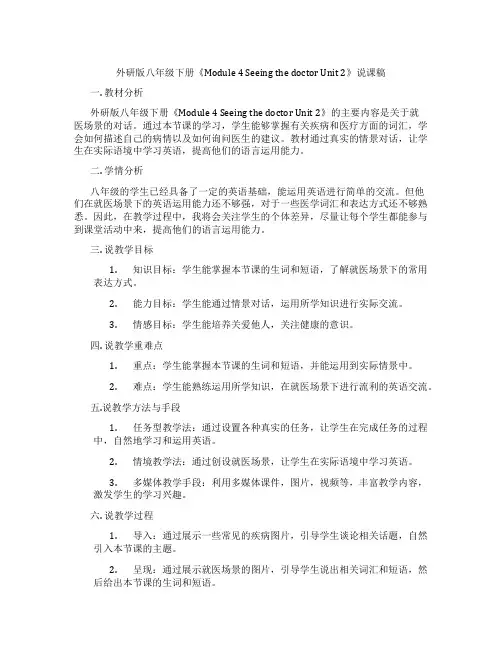
外研版八年级下册《Module 4 Seeing the doctor Unit 2》说课稿一. 教材分析外研版八年级下册《Module 4 Seeing the doctor Unit 2》的主要内容是关于就医场景的对话。
通过本节课的学习,学生能够掌握有关疾病和医疗方面的词汇,学会如何描述自己的病情以及如何询问医生的建议。
教材通过真实的情景对话,让学生在实际语境中学习英语,提高他们的语言运用能力。
二. 学情分析八年级的学生已经具备了一定的英语基础,能运用英语进行简单的交流。
但他们在就医场景下的英语运用能力还不够强,对于一些医学词汇和表达方式还不够熟悉。
因此,在教学过程中,我将会关注学生的个体差异,尽量让每个学生都能参与到课堂活动中来,提高他们的语言运用能力。
三. 说教学目标1.知识目标:学生能掌握本节课的生词和短语,了解就医场景下的常用表达方式。
2.能力目标:学生能通过情景对话,运用所学知识进行实际交流。
3.情感目标:学生能培养关爱他人,关注健康的意识。
四. 说教学重难点1.重点:学生能掌握本节课的生词和短语,并能运用到实际情景中。
2.难点:学生能熟练运用所学知识,在就医场景下进行流利的英语交流。
五.说教学方法与手段1.任务型教学法:通过设置各种真实的任务,让学生在完成任务的过程中,自然地学习和运用英语。
2.情境教学法:通过创设就医场景,让学生在实际语境中学习英语。
3.多媒体教学手段:利用多媒体课件,图片,视频等,丰富教学内容,激发学生的学习兴趣。
六. 说教学过程1.导入:通过展示一些常见的疾病图片,引导学生谈论相关话题,自然引入本节课的主题。
2.呈现:通过展示就医场景的图片,引导学生说出相关词汇和短语,然后给出本节课的生词和短语。
3.操练:通过各种练习活动,让学生熟练掌握生词和短语。
4.对话展示:让学生分组进行对话练习,展示他们的学习成果。
5.巩固:通过一些拓展活动,让学生进一步运用所学知识。
八年级英语下册Module 4 Seeing the doctor unit2教案 教案
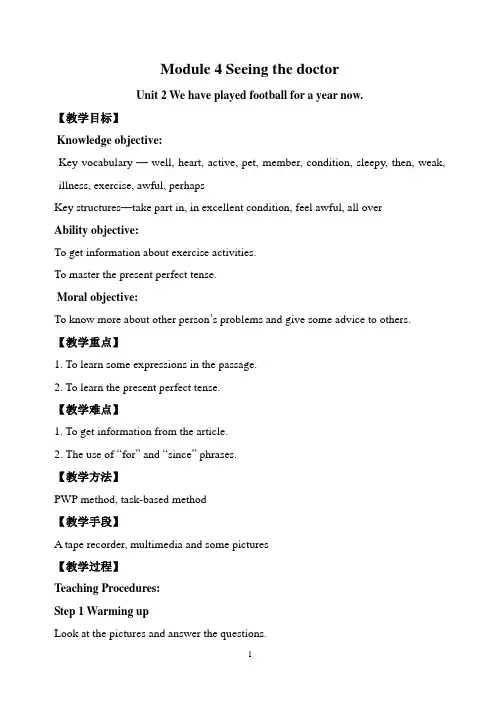
Module 4 Seeing the doctorUnit 2 We have played football for a year now.【教学目标】Knowledge objective:Key vocabulary — well, heart, active, pet, member, condition, sleepy, then, weak, illness, exercise, awful, perhapsKey structures—take part in, in excellent condition, feel awful, all overAbility objective:To get information about exercise activities.To master the present perfect tense.Moral objective:To know more about other person’s problems and give some advice to others.【教学重点】1. To learn some expressions in the passage.2. To learn the present perfect tense.【教学难点】1. To get information from the article.2. The use of “for” and “since” phrases.【教学方法】PWP method, task-based method【教学手段】A tape recorder, multimedia and some pictures【教学过程】Teaching Procedures:Step 1 Warming upLook at the pictures and answer the questions.1) What are they doing while they are watching TV?2) Is eating food while watching TV healthy?3) Playing volleyball often is healthy, isn’t it?4) How does he go to work every day?5) Is going to work by bike every day healthy?6) What do you do to keep healthy?Step 2 Consolidate new wordsLook and say.The teachers shows the pictures of new words and let the students to say as quickly as possible.well, heart, active, pet, member, condition, sleepy, then, weak, illness, exercise, awful, perhapsStep 3 Pre-reading1. Ss describe the activities in the pictures.2. Let Ss choose which ones are healthy.Step 4 ListeningListen to Part 2 and answer the questions.1) Did the doctor check Anna’s heart?2) How does Thomas go to work now?Keys: 1. Yes, he did.2. He rides to work.Step 5 Reading1. Read the passage and match the people with the pictures in Activity 1. There is one extra picture.2. Read the passage and answer the questions.1) How does Anna get exercise every day?2) Who was the first number of the girl’s football team?3) When did Thomas buy a bike?4) Was Richard weak after a long illness?Keys: 1. She gets exercise by taking the dog for a walk every day.2. Wang Wei.3. In January.4. Yes, he was.3. Complete the notes.Read the sentences and fill in the blanks according to the passage.Key: well, exercise, dog, walk, first, year, fit, underground, bike, smile, week, enjoy, weakStep 6 Complete the passage with the words in the box1. Read the passage from the beginning to the end carefully.2. Choose the right words to fill in the blanks.1) Tom runs six miles every morning, so he is in very good _________.2) Jill is a very ________ girl and plays lots of sports.3) I had a very bad headache yesterday, and I felt _________.4) Ben is a(n) _________ of the school football team.5) You do not look very well._________ you should see a doctor.6) I saw your grandfather taking his _______ walk this morning.Keys: condition, active, awful, member, Perhaps, dailyStep 7 Learning to learnLet Ss master the methods of learning English.You can often tell when a passage is asking for advice because it uses I rather than he/she to describe the problem. When you write your advice, you can use you …, you should/should not…and sentences like do …or do not …Step 8 Language pointsTo learn about the main points in the passage.1. I was not feeling very well.well表示“健康的”,是形容词。
外研版英语八下_Module 4 Unit 2 第二课时教案
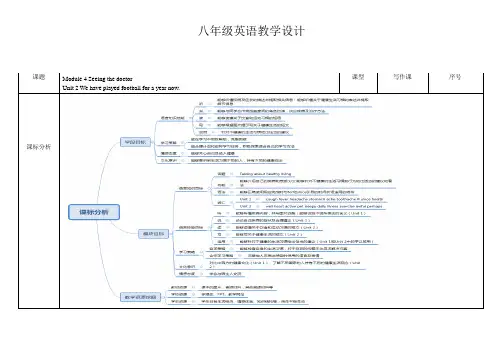
八年级英语教学设计课题Module 4 Seeing the doctor课型写作课序号Unit 2 We have played football for a year now.课标分析学习内容分析学情分析现实问题闭环式学习任务设计随着快速的生活节奏,我们的学生健康问题日益突出,学生需要能辨别健康与不健康的生活方式,能关心自己和他人健康,并给出合理的建议,制定适合的运动计划。
解决问题解决方案英语问题提出问题任务驱动合作交流展示完善抽象概括推广迁移应用了解健康生活方式,讨论哪些适用于中学生,并总结运用.读图猜测,Colin 遇到了哪些健康问题,你会给出什么建议,最后Colin 怎样了?Do a survey about how to keep healthy with your classmates and think about if they have good healthy living ways.学习目标(学习活动+学习主体+(行为程度)+评价活动)free talk 及work in groups. 90%的学生能运用上节课所学的现在完成时进行复述,其他10%在同伴帮助下复述。
通过跟读、自读、查读,85%的学生能准确流利朗读课文。
其他15%同学能读熟、读准文章中的重点短语和句型。
通过分析句子、小组合作,学习重要知识点的用法,95%学生能说出非延续性动词与延续动词转换、目标词汇及句型的意义和用法,并进行变式练习翻译句子。
其他同学能复述出他人总结的句子。
通过组内交流、运用所学目标词汇,80%同学能运用所给提示词描述不健康方式产生的原因,给出建议,采用的健康生活方式,以及健康生活方式之后的改变。
学生勤锻炼,养成健康的作息规律和生活习惯。
重点:运用生活习惯,生活方式的词汇、及句型写作文突破措施:先口头造句练习-----同伴互帮互评-----教师批改----两批三改 难点:非延续性动词与延续动词转换突破措施:自主总结归纳、分类理解记忆、小组互查题型设计层层递进、教师精讲点拨、二次巩固过关教学技术学具准备:课本、笔记本、笔教具准备:电脑、PPT、黑板、粉笔教学实施环节学习内容学生活动评价活动问题预设与补救措施1.融入情境,以旧促新(回扣目标1)根据图片复述课文内容教学内容:回顾文章的内容及结构。
Module4Unit2课件外研版英语八年级下册
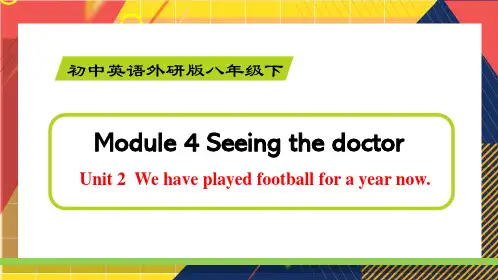
Module 4 Seeing the doctor
Unit 2 We have played football for a year now.
学习目标
1. To be able to understand passages about healthy living. 2. To write about healthy living with the hints provided by pictures.
My legs hurt and I am hot all over.
Perhaps I am too weak to do any exercise.
What do you think?
——Richard
短语总结
1. feel well (healthy/ fit)/ sleepy/ awful 感觉(到)身体好(健康)/困倦/不舒服
every day.
3
Complete the notes.
Wang Wei 4. She was the __fi_r_s_t __ member of the football team. 5. She has played football with the team for a __y_e_a_r_ and all the
suggested, “Why don’t we go for a run
before school?” So we started running a
week ago. But I do not enjoy running, and
when I get to school, I feel awful.
exercise awful
八年级英语下册Module 4 Seeing the doctor Unit2 说课稿
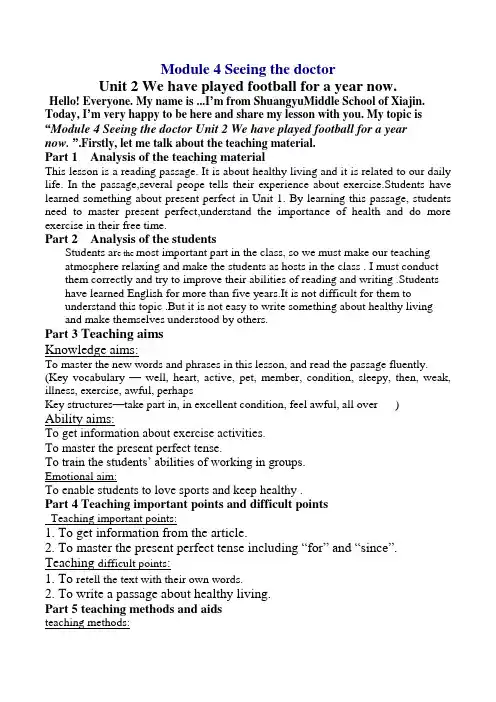
Module 4 Seeing the doctorUnit 2 We have played football for a year now.Hello! Everyone. My name is ...I’m from ShuangyuMiddle School of Xiajin. Today, I’m very happy to be here and share my lesson with you. My topic is “Module 4 Seeing the doctor Unit 2 We have played football for a year now.”.Firstly, let me talk about the teaching material.Part 1 Analysis of the teaching materialThis lesson is a reading passage. It is about healthy living and it is related to our daily life. In the passage,several peope tells their experience about exercise.Students have learned something about present perfect in Unit 1. By learning this passage, students need to master present perfect,understand the importance of health and do more exercise in their free time.Part 2 Analysis of the studentsStudents ar e the most important part in the class, so we must make our teachingatmosphere relaxing and make the students as hosts in the class. I must conduct them correctly and try to improve their abilities of reading and writing .Students have learned English for more than five years.It is not difficult for them tounderstand this topic .But it is not easy to write something about healthy living and make themselves understood by others.Part 3 Teaching aimsKnowledge aims:To master the new words and phrases in this lesson, and read the passage fluently. (Key vocabulary —well, heart, active, pet, member, condition, sleepy, then, weak, illness, exercise, awful, perhapsKey structures—take part in, in excellent condition, feel awful, all over )Ability aims:To get information about exercise activities.To master the present perfect tense.To train the students’ abilities of working in groups.Emotional aim:To enable students to love sports and keep healthy .Part 4 Teaching important points and difficult pointsTeaching important points:1. To get information from the article.2. To master the present perfect tense including “for” and “since”. Teaching difficult points:1. To retell the text with their own words.2. To write a passage about healthy living.Part 5 teaching methods and aidsteaching methods:PWP method, task-based methodTeaching aids:A tape recorder, multimedia and some picturesPart 6 Teaching proceduresStep 1 Warming upHave a free talk with the students.1.Show some pictures and ask them the questions:1)What’s wrong with the people?”2)Do you know how to keep healthy?2.Show the pictures to help them answer the questions.(设计意图:复习Unit 1所学内容,并导入本节话题,为后面学习做铺垫。
外研版八年级下册英语《Module4SeeingthedoctorUnit2》说课稿
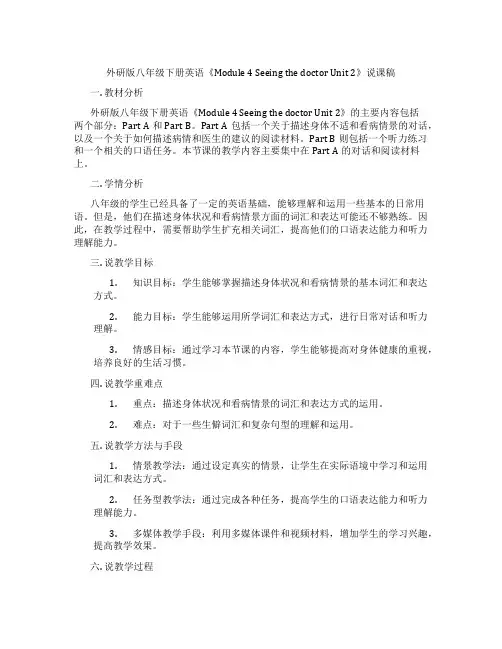
外研版八年级下册英语《Module 4 Seeing the doctor Unit 2》说课稿一. 教材分析外研版八年级下册英语《Module 4 Seeing the doctor Unit 2》的主要内容包括两个部分:Part A和Part B。
Part A包括一个关于描述身体不适和看病情景的对话,以及一个关于如何描述病情和医生的建议的阅读材料。
Part B则包括一个听力练习和一个相关的口语任务。
本节课的教学内容主要集中在Part A的对话和阅读材料上。
二. 学情分析八年级的学生已经具备了一定的英语基础,能够理解和运用一些基本的日常用语。
但是,他们在描述身体状况和看病情景方面的词汇和表达可能还不够熟练。
因此,在教学过程中,需要帮助学生扩充相关词汇,提高他们的口语表达能力和听力理解能力。
三. 说教学目标1.知识目标:学生能够掌握描述身体状况和看病情景的基本词汇和表达方式。
2.能力目标:学生能够运用所学词汇和表达方式,进行日常对话和听力理解。
3.情感目标:通过学习本节课的内容,学生能够提高对身体健康的重视,培养良好的生活习惯。
四. 说教学重难点1.重点:描述身体状况和看病情景的词汇和表达方式的运用。
2.难点:对于一些生僻词汇和复杂句型的理解和运用。
五. 说教学方法与手段1.情景教学法:通过设定真实的情景,让学生在实际语境中学习和运用词汇和表达方式。
2.任务型教学法:通过完成各种任务,提高学生的口语表达能力和听力理解能力。
3.多媒体教学手段:利用多媒体课件和视频材料,增加学生的学习兴趣,提高教学效果。
六. 说教学过程1.导入:通过提问学生关于身体健康的问题,引出本节课的主题。
2.新课呈现:讲解和展示本节课的主要词汇和表达方式。
3.情景练习:设定一个看病的情景,让学生进行角色扮演,运用所学词汇和表达方式。
4.听力理解:播放一段关于看病的情景对话,学生进行听力练习。
5.口语任务:学生分组进行口语任务,模拟看病的情景。
外研版八年级下册(新)《Module 4 Seeing the doctor Unit 2》公开课教
外研版八年级下册(新)《Module 4 Seeing the doctor Unit 2》公开课教学设计一. 教材分析《Module 4 Seeing the doctor Unit 2》的主要内容是学习在医院就医的场景,包括如何描述病情、如何询问医生以及如何表达药方的内容。
本节课的主要目标是让学生能够熟练运用所学知识,进行日常的就医交流。
二. 学情分析八年级的学生已经具备了一定的英语基础,对于日常的交流和表达已经能够熟练运用。
但是对于医学术语和表达方式可能还比较陌生,因此需要通过实例和情景的设置,让学生能够理解和运用。
三. 教学目标1.能够理解并运用以下词汇:fever, cough, sick, doctor, medicine,prescription。
2.能够表达自己的病情,并询问医生的建议。
3.能够理解并表达药方的内容。
四. 教学重难点1.重点:词汇的学习和运用,句型的掌握。
2.难点:医学术语的理解和运用,药方的表达方式。
五. 教学方法采用情境教学法,通过模拟医院就医的场景,让学生在实际操作中学习和掌握知识。
同时采用任务型教学法,通过设置不同的任务,让学生在完成任务的过程中,运用所学知识。
六. 教学准备1.准备相关的图片和场景,如医生、病人、药品等。
2.准备相关的词汇卡片。
3.准备模拟就医的场景。
七. 教学过程1.导入(5分钟)通过展示一些生病的图片,让学生猜测是什么病,从而引入本节课的主题。
2.呈现(10分钟)通过展示相关的词汇卡片,让学生学习和掌握相关的词汇。
同时,通过医生的询问和病人的回答,展示本节课的主要句型。
3.操练(10分钟)将学生分成小组,每组模拟就医的场景,让学生在实际操作中运用所学知识。
4.巩固(10分钟)通过一些练习题,让学生在纸上完成,以此巩固所学知识。
5.拓展(5分钟)让学生想象自己生病了,需要去看医生,写下自己与医生的对话。
6.小结(5分钟)对本节课所学知识进行小结,让学生明确学习的重点。
外研版八年级英语下册《Module4SeeingthedoctorUnit2》说课稿
外研版八年级英语下册《Module 4 Seeing the doctor Unit 2》说课稿一. 教材分析外研版八年级英语下册《Module 4 Seeing the doctor Unit 2》的主要内容围绕着生病就医的场景展开,通过学习本节课,学生能够掌握与看病相关的词汇和表达方式,学会如何描述病情和回答医生的问题。
教材中包含了丰富的对话和阅读材料,帮助学生提高听说读写的能力,并且能够运用所学知识解决实际问题。
二. 学情分析针对八年级的学生,他们在学习英语的过程中已经积累了一定的词汇量和基本语法知识,对于日常生活中的常用表达也有所了解。
但是,他们在实际运用英语进行交流时,往往会受到母语的干扰,特别是在描述具体场景和复杂情感时,可能会出现表达不清楚或者用词不当的情况。
因此,在教授本节课时,需要考虑到学生的实际情况,采取适当的教学方法帮助他们更好地理解和运用所学知识。
三. 说教学目标1.知识目标:学生能够掌握与看病相关的词汇和表达方式,如“see thedoctor”、“have a fever”、“have a cold”等;能够理解并运用一般现在时描述病情和回答医生的问题。
2.能力目标:学生能够通过听、说、读、写等多种方式,提高自己的英语综合运用能力;能够在日常生活中,运用所学知识进行简单的看病场景的交流。
3.情感目标:培养学生关爱他人,关注健康的意识,使他们能够关心他人的身体状况,主动就医,养成良好的生活习惯。
四. 说教学重难点1.重点:学生能够掌握与看病相关的词汇和表达方式,学会如何描述病情和回答医生的问题。
2.难点:学生能够运用一般现在时进行准确的病情描述,并在实际场景中灵活运用所学知识。
五. 说教学方法与手段在本节课的教学过程中,我将采用情境教学法、任务型教学法和交际法等教学方法。
通过创设生病就医的情境,让学生在真实的语境中学习与看病相关的词汇和表达方式;通过完成各种任务,提高学生的英语实践能力;通过小组合作和生生互动,激发学生的学习兴趣,提高他们的参与度。
外研版八年级下册英语《Module4SeeingthedoctorUnit2》说课稿3
外研版八年级下册英语《Module 4 Seeing the doctor Unit 2》说课稿3一. 教材分析《Module 4 Seeing the doctor Unit 2》这一单元的主题是关于就医的经历。
通过本单元的学习,学生将能够掌握与就医相关的词汇和表达方式,如:fever, illness, pn, medicine, doctor等。
同时,学生还能够学会如何描述自己的病情以及与医生的交流过程。
本单元的主要目标是培养学生运用英语进行就医场景的交际能力。
二. 学情分析八年级的学生已经掌握了基本的英语语法和词汇,具备一定的听说读写能力。
然而,学生在实际运用英语描述具体场景时,往往会因为词汇量的匮乏和表达方式的单一而感到困难。
此外,学生在就医场景中的实际交际经验较少,因此需要在课堂上进行大量的练习以提高交际能力。
三. 说教学目标1.知识目标:学生能够掌握本课的生词和短语,了解就医场景的常用表达方式。
2.能力目标:学生能够运用所学的词汇和表达方式,描述自己的病情并与他人进行就医场景的交际。
3.情感目标:通过本课的学习,学生能够提高对英语学习的兴趣,增强自信心。
四. 说教学重难点1.重点:学生能够掌握与就医场景相关的词汇和表达方式。
2.难点:学生能够运用所学的词汇和表达方式,在实际语境中进行就医场景的交际。
五. 说教学方法与手段1.情景教学法:通过模拟就医场景,让学生在实际语境中练习英语交际。
2.任务型教学法:通过完成具体的就医任务,提高学生的英语实际应用能力。
3.小组合作学习:鼓励学生互相交流、讨论,提高团队合作意识。
六. 说教学过程1.导入:教师通过提问方式引导学生思考就医场景,激发学生的学习兴趣。
2.展示:教师展示就医场景的图片或视频,引导学生进行观察和描述。
3.讲解:教师讲解本课的生词和短语,让学生进行实地操作,如模拟就医对话。
4.练习:学生进行小组讨论,模拟就医场景,练习英语交际。
外研版八年级下册 Module 4 Seeing the doctor Unit 2教案
外研版八年级下册Module 4 Seeing thedoctor Unit 2教案Module 4 Seeing the doctorUnit 2 We have played basketball for a year now.一、教学目标知识目标:1. 熟练掌握本单元词汇:well, heart, active, pet, member, take part in, then, daily, weak, exercise2. 能够读懂有关踢足球等运动话题的文章以及有关健康生活话题的文章。
3. 能够根据图片写出有关健康生活的小短文。
4. 能够针对不健康的生活习惯给出恰当的建议。
5. 养成健康生活的好习惯,协调好运动与学习的关系。
二、教学重点及难点重点:熟练掌握本单元词汇。
难点:能够读懂有关踢足球等运动话题的文章以及有关健康生活话题的文章;并能够根据图片写出有关健康生活的小短文。
三、教学准备1. 多媒体设备和课件;2. 教学光盘。
四、教学过程Step I Warming-upWatch and discussSs watch the video Organ Story and talk about the following questions. What does the man do to make his body worseCan you give him some advice about keeping healthy设计意图:通过观看有关身体器官的动画视频,再通过问题的讨论与思考,引出本单元有关健康的话题,激发学生的学习热情。
Think and sayT let Ss think about how to keep healthy Then Ss share their opinions. Look and answerT shows some pictures to Ss and talk about some questions about health. T: Now let’s review what we have learned last class. Look at the pictures and think about the questions—What’s wrong with the people What should he or she do What are they doing while they are watching TV Is eating food while watching TV healthy设计意图:通过图片复习所学内容,加深学生对已学知识的印象。
- 1、下载文档前请自行甄别文档内容的完整性,平台不提供额外的编辑、内容补充、找答案等附加服务。
- 2、"仅部分预览"的文档,不可在线预览部分如存在完整性等问题,可反馈申请退款(可完整预览的文档不适用该条件!)。
- 3、如文档侵犯您的权益,请联系客服反馈,我们会尽快为您处理(人工客服工作时间:9:00-18:30)。
Module 4 Seeing the doctor第8课时分层训练[Unit 2 & Unit 3]Ⅰ.根据句意及首字母或汉语提示完成句子1.My mother always tells me to put my ________ (心) into my study.2.Simon is one of the ________ (会员) of the football club in our city.3.We can't imagine what our ________ (日常的) life will be like without the Internet.4.—Why didn't he answer my phone?—P________ he was busy at that time.5.After staying in bed for a long time, the old man is still too w________ to stand up by himself.6.Tom is a very a________ boy and he likes lots of sports.Ⅱ.用所给词的适当形式填空1.He had to leave school because of his ________ (ill).2.2017·宿迁Bob stayed up late last night and now he feels ________ (sleep).3.When I walked past the hall, I saw some girls________(sing) there.4.The doctor suggests ________ (go) for a run every day.5.2017·镇江Nick's mother worries about his ________ (health) lifestyle, thoughhe is a college student.Ⅲ.用方框中所给短语的适当形式填空2.Why don't we ________________ before school?3.Our teacher is the coach, so she also ____________________ the training with us.4.I ________________ maths. I hope you can help me.5.My grandparents are _________________ though they have already been in their eighties.Ⅰ.单项填空( )1.You can improve your English ________ reading more.A.in B.withC.by D.of( )2.—I think our chemistry teacher is working hard. He teaches us ________.—Yes, but he hasn't come today. He doesn't feel ________.A.good; well B.good; goodC.well; good D.well; well( )3.I felt ________ last night, and then I fell ________ quickly.A.sleepy; asleep B.asleep; asleepC.sleepy; sleepy D.asleep; sleepy( )4.2017·武汉—How are you today?—Oh, I ________ as ill as I do now for a long time.A.didn't feel B.wasn't feelingC.don't feel D.haven't felt( )5.2017·宿迁—Have you heard that Lin Tao saved his neighbour from a big fire last night?—Yes. ________ brave young man he is!A.How B.How aC.What D.What aⅡ.连词成句根据括号内的中文提示,将所给的英文意群连接成正确的句子。
1.computer, is, works, my, well, it, excellent, very, in, condition(我的电脑状况良好,它运行非常好。
)________________________________________________________________________ 2.took part in, year, girl, the, last, the Olympic Games(那个女孩去年参加了奥运会。
)________________________________________________________________________ 3.came into, our, her, the, a smile, classroom, with, on, teacher, face(我们的老师面带微笑走进了教室。
)________________________________________________________________________ 4.shouldn't, as, playing, our, spend, we, all, computer, teenagers, time, games(作为青少年,我们不应该把所有的时间都花在玩电脑游戏上。
)________________________________________________________________________ 5.young, the, clear up, girl, is, to, schoolbag, the, in, her, too, things(这个女孩太小,还不能清理她书包里的物品。
)________________________________________________________________________ Ⅲ.按要求完成下列各题1.Betty started to learn Chinese in 2010.(用since改为现在完成时)Betty ________ ________ Chinese ________ 2010.2.She got up so late that she couldn't catch the early bus.(改为同义句) She got up ________ late ________ ________ the early bus.3.Why don't we play basketball after school ? (改为同义句)________ ________ ________ basketball after school?4.They have been in Beijing since_they_were_born.(对画线部分提问)________ ________ ________ they been in Beijing?5.We all know what we should do to keep away from disease. (改为简单句) We all know ________ ________ ________ to keep away from disease.Ⅳ.2017·凉山改编选词填空根据短文内容,从方框中选择适当的单词填空,使短文意思完整。
每个单词只能用一次,每空一词。
others, really, worries, communication,having, be, a, braver, like, helpfulShare your feelings when you need help. Sharing a problem is like cutting it in half. However, maybe it's 1.________ hard to tell someone that you are feeling sad or worried. If you think you are too shy and want to be a little 2.________ than before, just try the following things.Talk with your dad or mum, who cares a lot about you, and you may feel much better. Don't forget your parents have more experience, and are always there to help you. But sometimes the 3.________ between parents and children is also a problem. So if you don't want to talk with your father or mother, what should you do? It's better to find another you trust to talk to, 4.________ a teacher or a friend. This helpsyou feel more comfortable.Once you know who you can talk to, you should choose when and where to talk. If you think it's difficult for you to say what you think, write it down on a piece of paper. Perhaps it's more 5.________. If the person can't understand what you mean right away, try to say it in a different way or give an example. Build confidence gradually by talking 6.________ small step every time.Then try to 7.________ a good talker. Don't waste time worrying about your look or what people think of you. If you find it hard to start a conversation, say something nice about people around you. Think about how great you feel when someone says something nice to you. Doesn't it make you want to keep talking to that person? It is worth 8.________ a try!Problems and 9.________ are normal in life. If you keep them in your heart and don't talk about them with 10.________, you will even fall ill at last. It is the best not to run away from your problems. Just talk to someone about a problem, and you are halfway to solving it.Ⅴ.2017·青岛阅读理解Our skin is like a bag that we live in. Inside the bag our bodies are mostly water. Our water is like the water in the sea. It is very salty. Also, like the ocean, we can lose our water. The wind and the sun could take it away. Our bag of skin keeps our body's ocean from drying up.Our skin keeps out sunshine. Too much sunshine can hurt us. Skin also keeps out dirt. That's important because some kinds of dirt can make us sick. Our skin feels things. It feels warm things, cold things, things it touches, and things that hurt it. A campfire feels warm. A snowball thrown in our face feels cold and hurts us.A hug is the touch of another person's skin on our own.Our hair is a special kind of covering. It helps us keep things out of our eyes,ears and nose. Hair is also good for keeping us warm. When we get goose bumps(鸡皮疙瘩), our body hairs stand up. Then the hairs hold air close to our skin like a thick blanket(毯子). Hair keeps animals warm, too. Some animals have more hair than others, so they have a better blanket for cold weather.Our nails(指甲) are another special skin which are very hard. They help keep our fingers from getting hurt. Our nails aren't as strong as the nails that animals have. But they are good for picking up coins.根据短文内容判断正误,正确的填A, 错误的填B。
